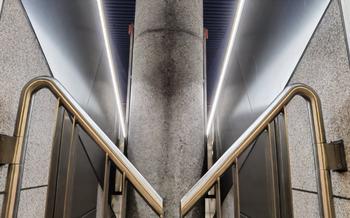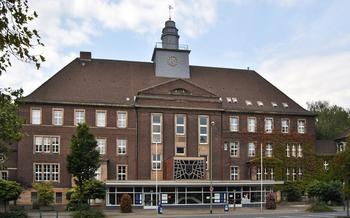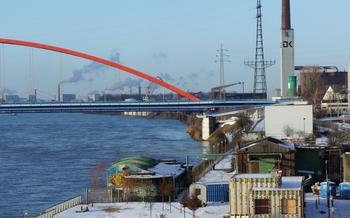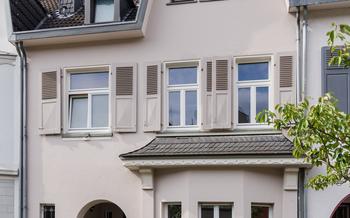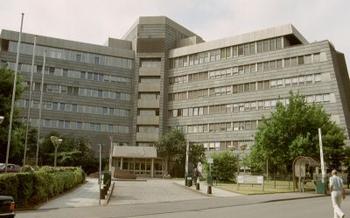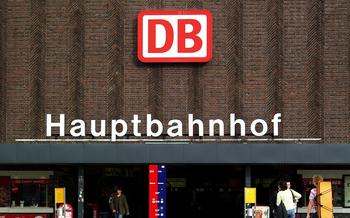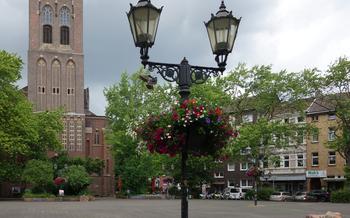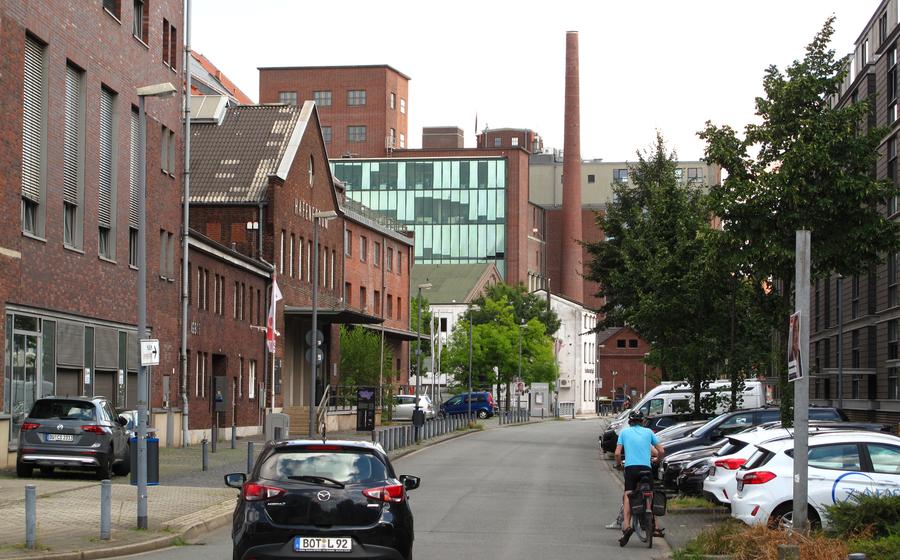
SchiffahrtMuseum im Schwanentor
- The SchiffahrtMuseum im Schwanentor: A Voyage Through Maritime History
- The Swan Gate: A Gateway to the Past
- A Journey Through the Museum's Galleries
- The Rhine River: A Vital Waterway
- The Port of Duisburg: A Hub of Industry
- Shipbuilding in Duisburg: A Proud Tradition
- The People of the River: Riverine Communities
- The Duisburg Port Museum: A Complementary Experience
- The City of Duisburg: Beyond the Museum
- Planning Your Visit: Tips and Practical Information
- Enhancing Your Experience: Educational Programs and Events
- Capturing the Moment: Photography and Social Media
- Local Cuisine: A Taste of Duisburg's Culinary Delights
- Insider Tip: Unveiling Duisburg's Hidden Gems
The SchiffahrtMuseum im Schwanentor: A Voyage Through Maritime History
The SchiffahrtMuseum im Schwanentor, or the Inland Shipping Museum in the Swan Gate, is a treasure trove of maritime history nestled in the heart of Duisburg, Germany. It invites visitors on an immersive journey through the city's rich connection to the water, showcasing the significance of the Rhine River, the bustling port, and the proud shipbuilding tradition that shaped Duisburg's identity.
Located at the historic gatehouse of the Schwanentor, the museum's strategic position reflects its focus on Duisburg's maritime heritage. The Schwanentor, once a crucial part of the city's medieval fortifications, now serves as a gateway to the past, inviting visitors to explore the fascinating world of inland shipping and its impact on Duisburg's development.
The Swan Gate: A Gateway to the Past
The SchiffahrtMuseum im Schwanentor is housed in the historic Schwanentor, or Swan Gate, a magnificent 14th-century gate that once served as part of Duisburg's city fortifications. The gate, with its imposing towers and intricate brickwork, is a stunning example of medieval architecture and a testament to the city's rich history.
Constructed in the late 14th century, the Schwanentor was one of several gates built to protect Duisburg from attack. The gate's strategic location at the confluence of the Rhine and Ruhr rivers made it a critical point of defense for the city. The gate's name, "Swan Gate," is thought to derive from a nearby inn that featured a swan as its emblem.
Throughout its history, the Schwanentor has played a pivotal role in Duisburg's defense. During the Thirty Years' War, the gate withstood several sieges and attacks, demonstrating its strength and resilience. In the 19th century, the gate underwent extensive restoration, preserving its historical integrity and ensuring its continued existence as a symbol of Duisburg's rich past.
A Journey Through the Museum's Galleries
The SchiffahrtMuseum im Schwanentor offers a captivating journey through history, showcasing Duisburg's maritime heritage in a series of thematic galleries. Visitors can explore the city's shipbuilding industry, its role in trade and commerce, and the lives of the people who worked on the river.
One of the highlights of the museum is the "Shipbuilding in Duisburg" gallery. This section delves into the city's rich shipbuilding tradition, showcasing models of historic vessels, tools, and machinery used in the shipyards. Visitors can learn about the challenges and innovations that shaped Duisburg's shipbuilding industry, which played a crucial role in the city's economic development.
Another must-see gallery is "The Rhine River: A Vital Waterway". This exhibit explores the significance of the Rhine River in Duisburg's history and development. Visitors can trace the river's course through the city, learn about its role in trade and transportation, and discover the impact it has had on the city's culture and economy.
The museum also features a gallery dedicated to "Maritime Trade and Commerce". This section showcases Duisburg's global connections, highlighting the city's trading partners and the commodities that were exchanged. Visitors can learn about the impact of maritime trade on Duisburg's economy and how it shaped the city's identity as a center of commerce.
The Rhine River: A Vital Waterway
The imposing Rhine River, a significant European waterway, has played a pivotal role in shaping Duisburg's destiny. The museum's exhibits eloquently narrate the river's profound impact on the city's development. Visitors can delve into the annals of time, learning how the river's mighty currents propelled Duisburg into a flourishing trade and transportation hub. The museum's collection showcases the Rhine's transformation over the centuries, from a natural wonder to a bustling artery of commerce.
Interactive displays engage visitors, allowing them to virtually navigate the river's treacherous rapids and experience the thrill of sailing its vast expanse. The museum also sheds light on the Rhine's ecological significance, highlighting the diverse flora and fauna that thrive along its banks. Through captivating exhibits and immersive experiences, the SchiffahrtMuseum im Schwanentor unveils the intricate bond between Duisburg and the Rhine, a river that has indelibly shaped the city's past, present, and future.
The Port of Duisburg: A Hub of Industry
The SchiffahrtMuseum im Schwanentor not only delves into Duisburg's maritime heritage but also sheds light on the city's industrial prowess. Duisburg's port, situated at the confluence of the Rhine and Ruhr rivers, has played a pivotal role in the city's economic development.
Exhibits at the museum provide a comprehensive overview of the port's history, from its humble beginnings to its transformation into one of the largest inland ports in the world. Visitors can learn about the port's operations, the diverse range of goods that pass through it, and its impact on Duisburg's economy.
Interactive displays and multimedia presentations bring the port's activities to life, allowing visitors to witness the bustling atmosphere and the intricate logistics involved in handling vast quantities of cargo. The museum also highlights the port's role in facilitating Duisburg's industrial growth, particularly in the steel and coal industries.
Through these exhibits, the SchiffahrtMuseum im Schwanentor offers a fascinating glimpse into Duisburg's industrial heritage and the crucial role that the port has played in shaping the city's identity.
Shipbuilding in Duisburg: A Proud Tradition
Duisburg's rich shipbuilding heritage is a testament to the city's maritime prowess. The museum's exhibits delve into the history of shipbuilding in Duisburg, showcasing the skills and expertise of the city's shipbuilders. Visitors can learn about the different types of vessels constructed in Duisburg, from small boats to large cargo ships.
Interactive displays allow visitors to explore the shipbuilding process, from design and construction to launch and sea trials. The museum also features models and replicas of historic ships, providing a glimpse into the craftsmanship and engineering that went into these vessels. Visitors can trace the evolution of shipbuilding techniques over the years and gain insights into the challenges and innovations that shaped the industry.
The legacy of Duisburg's shipyards lives on in the form of the many vessels that were built here and sailed the world's oceans. These ships carried goods, transported passengers, and played a vital role in trade and exploration. The museum pays homage to the men and women who worked in the shipyards, whose skills and dedication contributed to Duisburg's maritime success.
The People of the River: Riverine Communities
The SchiffahrtMuseum im Schwanentor not only focuses on the technical aspects of maritime history but also sheds light on the lives of those who worked on the Rhine River. Through various exhibits, visitors can gain insights into the challenges and rewards of river life, as well as the cultural traditions and heritage of riverine communities.
One of the exhibits highlights the daily lives of boatmen and their families. It showcases the cramped living quarters on board the vessels, the dangers they faced during their journeys, and the camaraderie that developed among them. Visitors can also learn about the role of women in riverine communities, who often played a vital role in maintaining the household and raising the children while their husbands were away.
Another exhibit focuses on the cultural traditions and festivals associated with river life. Visitors can explore the significance of events such as the Rhine in Flames festival, which celebrates the river's beauty and history with spectacular fireworks displays and boat processions. They can also learn about the unique customs and superstitions that were prevalent among riverine communities, such as the belief that whistling on a boat could bring bad luck.
By delving into the lives of the people who worked on the Rhine, the SchiffahrtMuseum im Schwanentor offers a comprehensive understanding of the human side of maritime history. Visitors can gain a deeper appreciation for the challenges and triumphs of those who made their living on the river, and how their lives and traditions shaped the cultural fabric of Duisburg and the surrounding region.
The Duisburg Port Museum: A Complementary Experience
The Duisburg Port Museum, located in the heart of the city's vibrant harbor, serves as a compelling complement to the SchiffahrtMuseum im Schwanentor. Dedicated to showcasing the history and operations of the Port of Duisburg, this museum offers a comprehensive insight into the city's maritime legacy.
Through captivating exhibits and interactive displays, visitors can delve into the port's transformation from a modest trading hub to one of the largest inland ports in the world. The museum highlights the port's role in facilitating global trade, driving industrial growth, and shaping the economic landscape of the region.
The Duisburg Port Museum provides a unique perspective on the city's maritime heritage, complementing the broader narrative presented at the SchiffahrtMuseum im Schwanentor. By exploring both museums, visitors gain a comprehensive understanding of Duisburg's rich maritime history and its enduring significance in shaping the city's identity.
The City of Duisburg: Beyond the Museum
Duisburg offers a wealth of cultural and historical attractions beyond the SchiffahrtMuseum im Schwanentor. Visitors can immerse themselves in the city's rich past at the Duisburg City Museum, which showcases the city's history from its medieval origins to its industrial heyday. The Lehmbruck Museum houses an impressive collection of sculptures by the renowned artist Wilhelm Lehmbruck, while the Kultur- und Stadthistorisches Museum offers insights into the city's social and cultural history.
For those seeking a unique experience, a visit to the Landschaftspark Duisburg-Nord is a must. This former industrial site has been transformed into a vibrant park, offering stunning views of the city's industrial heritage. Visitors can explore the park's many attractions, including climbing walls, a diving tower, and a high ropes course.
Nature enthusiasts will delight in the Duisburg Zoo, home to over 2,000 animals from all over the world. The zoo is particularly renowned for its collection of big cats, including lions, tigers, and leopards.
Combining a visit to the SchiffahrtMuseum im Schwanentor with other activities in Duisburg creates a well-rounded experience for visitors. Whether exploring the city's historical landmarks, immersing oneself in art and culture, or enjoying the outdoors, Duisburg offers something for everyone.
Planning Your Visit: Tips and Practical Information
Visiting the SchiffahrtMuseum im Schwanentor should be a well-planned endeavor to make the most of your experience. The museum's hours of operation vary depending on the day of the week. It is typically open from Tuesday to Sunday, with extended hours on some days. Admission fees are reasonable, with discounts available for students, seniors, and families. Guided tours are offered at an additional cost, providing an in-depth exploration of the exhibits with knowledgeable guides.
The museum is committed to accessibility, ensuring that visitors with disabilities can fully enjoy their visit. Wheelchair ramps, elevators, and accessible restrooms are available throughout the museum. Additionally, the museum provides wheelchairs for those who may need them.
To enhance your experience, the museum offers a range of facilities and amenities. Lockers are available for storing personal belongings, and a cloakroom is provided for larger items. A museum shop offers a variety of souvenirs, books, and educational materials related to the exhibits. Additionally, a café provides a welcoming space to relax and enjoy refreshments.
Enhancing Your Experience: Educational Programs and Events
Enhancing your visit to the SchiffahrtMuseum im Schwanentor doesn't stop at exploring its exhibits. The museum offers a range of educational programs and events that delve deeper into Duisburg's maritime history and provide opportunities for hands-on learning and engagement.
For schools and groups, the museum has tailored educational programs that bring history to life. Interactive workshops, guided tours, and hands-on activities allow students to explore the museum's collection and gain insights into the city's maritime heritage. These programs are designed to spark curiosity and foster a love for learning.
The museum also hosts special events, workshops, and lectures throughout the year. These events provide a platform for experts, historians, and enthusiasts to share their knowledge and insights on various aspects of maritime history. From lectures on shipbuilding techniques to workshops on traditional navigation methods, these events offer unique learning experiences for visitors of all ages.
For those seeking a more immersive experience, the museum offers opportunities for hands-on learning and engagement. Visitors can participate in interactive exhibits that simulate sailing a ship or try their hand at knot-tying and other traditional maritime skills. These hands-on experiences provide a deeper understanding of the challenges and rewards of life on the water.
Capturing the Moment: Photography and Social Media
Visitors to the SchiffahrtMuseum im Schwanentor are encouraged to capture their experiences through photography and share them on social media. While documenting your journey through the museum's galleries, please adhere to the following guidelines:
-
Respect the Museum's Collection: Flash photography is strictly prohibited to protect the delicate artifacts and exhibits. Please use natural light or low-light settings to ensure the preservation of these valuable pieces.
-
Consider Other Visitors: While taking photos, be mindful of other visitors' enjoyment of the exhibits. Avoid blocking their view or causing disruptions during guided tours.
-
Tag the Museum: Share your photos and experiences on social media using the hashtag #SchiffahrtMuseumDuisburg. Tagging the museum's official accounts (@schiffahrtsmuseum_duisburg) will allow us to feature your content and connect with a broader community of maritime enthusiasts.
-
Share Your Insights: Accompany your photos with informative captions that provide context and insights into the exhibits. Share your thoughts on the museum's collection, the history of Duisburg, or the significance of the Rhine River.
By following these guidelines and sharing your experiences online, you can help promote the SchiffahrtMuseum im Schwanentor and inspire others to explore the rich maritime heritage of Duisburg.
Local Cuisine: A Taste of Duisburg's Culinary Delights
A visit to the SchiffahrtMuseum im Schwanentor is not complete without savoring the delectable local cuisine that Duisburg has to offer. The city's culinary scene is a delightful blend of traditional German flavors and international influences, with a special emphasis on dishes that reflect its maritime heritage.
For a taste of authentic Duisburg cuisine, head to one of the many traditional restaurants or cafes in the city center. Here, you can indulge in hearty dishes such as Himmel und Äad (a regional specialty of black pudding and mashed potatoes), Rheinischer Sauerbraten (marinated beef with a sweet and sour sauce), or Niederrheinischer Reibekuchen (potato pancakes).
If you're looking for something a bit more contemporary, Duisburg also has a vibrant selection of international restaurants. From Italian trattorias to Asian bistros, there's something to suit every palate.
To truly embrace Duisburg's maritime heritage, be sure to try some of the local fish dishes. The city's proximity to the Rhine River means that fresh fish is always on the menu. Whether you prefer grilled salmon, fried cod, or a traditional fish soup, you're sure to find something to your liking.
And for a sweet treat, don't miss the chance to try some of Duisburg's famous pastries. The city is known for its delicious cakes, cookies, and tortes, many of which are inspired by the region's rich culinary traditions.
So, after a fascinating journey through the SchiffahrtMuseum im Schwanentor, be sure to take some time to explore Duisburg's culinary scene and savor the flavors of this vibrant city.
Insider Tip: Unveiling Duisburg's Hidden Gems
For an extended exploration of Duisburg's maritime legacy, venture beyond the SchiffahrtMuseum im Schwanentor. The Ruhrort district, once a bustling port area, exudes a distinct maritime charm with its historic buildings and cobblestone streets. Explore the district's harbor, where old warehouses and cranes stand as silent witnesses to Duisburg's industrial past.
Ascend the Duisburg Kaiserberg, a man-made mountain created from mining waste, for panoramic vistas of the city and the Rhine River. This unique vantage point offers a fresh perspective on Duisburg's industrial heritage and its transformation into a modern metropolis.
Finally, stroll along the Rhine promenade, a scenic pathway that hugs the riverbank. Admire the passing barges and ships while relishing the tranquility of this riverside oasis. The promenade offers a serene contrast to the industrial ambiance of the city, providing a delightful respite during your exploration of Duisburg.
